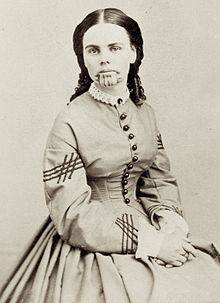
Back شوفان الزيتون ARZ Olive Oatman German Όλιβ Όουτμαν Greek Olive Oatman Spanish Olive Oatman Basque Olive Oatman French Olive Oatman Italian Olive Oatman Polish Отмэн, Олив Russian Олив Овтмен RUE
This article needs additional citations for verification. (July 2022) |
Olive Oatman | |
|---|---|
 Olive Oatman c. 1863 | |
| Born | Olive Ann Oatman September 7, 1837 La Harpe, Illinois, U.S. |
| Died | (aged 65) Sherman, Texas, U.S. |
| Resting place | West Hill Cemetery |
| Other names | Olive Oatman Fairchild, Oach |
| Alma mater | University of the Pacific |
| Spouse |
John Brant Fairchild
(m. 1865) |
| Children | Mary Elizabeth Fairchild (adopted) |
Olive Ann Oatman (September 7, 1837 – March 21, 1903) was a White American woman who was enslaved and later released by Native Americans in the Mojave Desert region when she was a teenager.[1] She later lectured about her experiences.
On March 18, 1851, while emigrating from Illinois to the confluence of the Colorado River and the Gila River (in modern-day Yuma, Arizona), her family was attacked by a small group from a Native American tribe.[1] Though she identified them as Apache, they were most likely Tolkepayas (Western Yavapai).[citation needed] They killed her parents and 4 siblings, left her older brother Lorenzo Dow Oatman (1836–1901) for dead, and enslaved Olive and her younger sister Mary Ann, holding them as slaves for one year before they traded them to the Mohave people.[2][3]: 85 While Lorenzo exhaustively attempted to recruit governmental help in searching for them, Mary Ann died from starvation and Olive spent four years with the Mohave.
Five years after the attack, she was repatriated into American society. The story of the Oatman Massacre began to be retold with dramatic license in the press, as well as in her own memoir and speeches. Novels, plays, movies, and poetry were inspired, which resonated in the media of the time and long afterward. She had become an oddity in 1860s America, partly because of the prominent blue tattooing of her chin by the Mohave, making her the first known White woman with Native tattoo on record.[4] Much of what actually occurred during her time with the Native Americans remains unknown.[5]: 146–51
- ^ a b McLeary, Sherrie S.; McGinty, Brian (June 12, 2010). "Fairchild, Olive Ann Oatman". Texas State Historical Association. Retrieved August 5, 2022.
- ^ Braatz, Timothy (2003). Surviving Conquest. Lincoln, Nebraska: University of Nebraska Press. pp. 253–54.
- ^ Cite error: The named reference
McGintywas invoked but never defined (see the help page). - ^ Wild, Chris (February 28, 2015). "The story of the young pioneer girl with the tattooed face". Mashable. Retrieved November 5, 2019.
- ^ Mifflin, Margot (2009). The Blue Tattoo: The Life of Olive Oatman (PDF). Lincoln, NE: University of Nebraska Press. ISBN 9780803235175. OCLC 1128156875. Archived from the original (PDF) on March 6, 2016. Retrieved June 19, 2016.